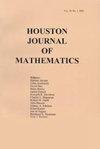Bifurcation theory for a class of second order differential equations
IF 0.3
4区 数学
Q4 MATHEMATICS
引用次数: 0
Abstract
We consider the existence of positive solutions of the nonlinear two point boundary value problem u′′ + λf(u) = 0, u(−1) = u(1) = 0, where f(u) = u(u − a)(u− b)(u− c)(1−u), 0 < a < b < c < 1, as the parameter λ varies through positive values. Every solution u(x) is an even function, and when it exists, it is uniquely identified by α = u(0). We study how the number of solutions changes when the parameter varies, i.e. we will be focusing on the locations of bifurcation points. The authors P. Korman, Y. Li and T. Ouyang ( ”Computing the location and the direction of bifurcation”, Mathematical Research Letters, accepted ), prove that a necessary and sufficient condition for α to be a bifurcation point is G(α) ≡ F (α) ∫ α 0 f(α)− f(τ) [F (α)− F (τ)]3/2 dτ − 2 = 0, where F (α) = ∫ α 0 f(u) du. We will prove that G(α) has vertical asymptotes at α = b, α = 1 and at any point α ∈ (0, 1) for which ∫ α 0 f(u) du = 0. We will use the asymptotic behavior of G to estimate intervals where G(α) 6= 0, that is, intervals where there is no bifurcation point.一类二阶微分方程的分岔理论
考虑了非线性两点边值问题u ' + λf(u) = 0, u(−1)= u(1) = 0,其中f(u) = u(u−a)(u−b)(u−c)(1−u), 0 < a < b < c < 1,且参数λ随正数值变化时正解的存在性。u(x)的每一个解都是偶函数,当它存在时,它被α = u(0)唯一标识。我们研究当参数变化时解的数目是如何变化的,即我们将关注分岔点的位置。作者P. Korman, Y. Li和T. Ouyang(“计算分岔的位置和方向”,《数学研究通讯》,已接受)证明了α是分岔点的一个充分必要条件是G(α)≡F (α)∫α 0 F (α)−F (τ) [F (α)−F (τ)]3/2 dτ−2 = 0,其中F (α) =∫α 0 F (u) du。我们将证明G(α)在α = b, α = 1以及在任意点α∈(0,1)且∫α 0 f(u) du = 0处具有垂直渐近线。我们将利用G的渐近性质来估计G(α) 6= 0的区间,即不存在分岔点的区间。
本文章由计算机程序翻译,如有差异,请以英文原文为准。
求助全文
约1分钟内获得全文
求助全文
来源期刊
CiteScore
0.80
自引率
0.00%
发文量
0
审稿时长
6 months
期刊介绍:
The Houston Journal of Mathematics appears quarterly and publishes original research papers on mathematical topics. It welcomes contributed papers that develop interesting, or important, new mathematical ideas and results or solve outstanding problems. All papers are refereed for correctness and suitability for publication.

 求助内容:
求助内容: 应助结果提醒方式:
应助结果提醒方式:


